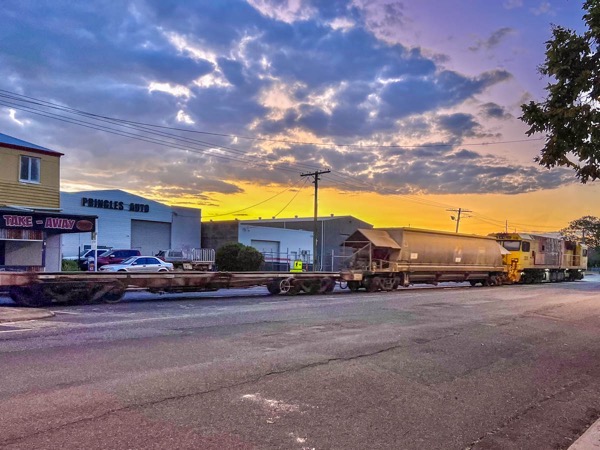
We only had a litle over 200 kilometres to travel today, but somehow it still took us all day. We began with a look around the town of Agnes Water and its adjoining town of Seventeen Seventy and then drove north to Rockhampton.
The town of 1770 has officialy changed its name to Seventeen Seventy (letters, not numbers). It is named so because it is the place where on Wednesday 24 May 1770, Lieutenant (before he was promoted to captain) James Cook anchored the Endeavour about 3 km off the coast and came ashore.
He landed near Round Hill Head with botanist Joseph Banks and his assistant Daniel Solander. It was only the second time during his voyage of discovery that he had set foot on Australian soil. The party landed at the south point of the bay where they found a channel leading into a large lagoon. Cook wrote: “In this place there is room for a few ships to lie in great security, and a small stream of fresh water”. They noted many pelicans and, upon the shore, a species of bustard, one of which was shot. They considered it the best bird they had eaten since leaving England, and in honour of it they called the inlet Bustard Bay.

Before reeaching the major port city of Gladstone, we took a short detour to a place named Tannum Sands. It didn’t look very big on the map and I was expecting to find just a small village. Instead, we found it be a large community where some street intersections even had traffic lights. It did have a beautiful long beach of golden sand that stretched for kilometres.

In Gladstone, we tried to find a picnic table for lunch. Our map told us there were some potential spots at Spinnacker Point that overlooked the coal port. Theere were indeed some nice grassed areas along the point but we were stuck behind a very slow moving 4WD vehicle which braked and almost stopped at every speed bump on the road. We could see other people moving towards picnic tables as we slowly followed along. If we had have been abkle to mover faster,, we could have captured any one of them. How frustrating! Eventually, we found a vacant table and even though it was a little breezy, we enjoyed a lunch in the sunshine. The weather was quite nice today – clear and sunny with a temperature of 27C.
Gladstone feels like a genuinely industrial city. it has an enormous power station, a huge port, a large coal loading wharf and an aluminium smelter. More than 100 million tonnes of cargo of over thirty products pass through the port each year. In the last three decades this quiet port has developed some of the most sophisticated bulk loading facilities in the country.

Just before reaching our destination city of Rockhampton, we crossed the Tropic of Capricorn. We are now around 2000 kilometres away from home by road, althoough we have probably added 40 to 50% more distance than this because we have explored many towns and locations along the way.
Rockhampton is a charming regional city. The central business district, particularly Quay Street (which is part of the National Estate) and East Street, probably has the most elegant, and well preserved, streetscape in the country. The concentration of beautiful old buildings, the tree lined streets, the gently flowing Fitzroy River beside Quay Street, all make this area of Rockhampton’s CBD very attractive.

An enormous amount of money poured into Rockhampton in the 1880s because of a gold rush. So much that in 1869 a noted architect (Mr J Flint) was commissioned to design and build the very large Criterion Hotel that faces the river. The colonnaded verandas have hoods to protect the rooms from the harsh Queensland sun. It remained in the original family until 1946. Over the years it has been host to dignitaries including the actor Gary Cooper, the US General Douglas MacArthur, Donald Bradman and Sir Robert Menzies.

There are many beautiful buildings along the sreet that fronts the Fizroy River. One of the most outstanding is the old customs house. This huge building has a huge copper dome and an elaborate semi-circular portico with a Corinthian colonnade. Rockhampton ceased to be a river port in 1958 but Customs remained in the building until 1986.

Our hotel for the night, the Denison Boutique Hotel was constructed in 1886 to a design prepared in the Office of the Chief Engineer for Railways. It was originally a railway adminstration building. It reflects the importance of Rockhampton as the coastal terminus of the Central Western railway line and the important role the railway played in opening the Rockhampton hinterland and central western Queensland to settlement, pastoralism and mining during the last three decades of the 19th century.

We finished our day with two interesting discoveries. Firstly, we had trouble finding somewhere to eat. On Mondays, most of the pubs, and even the Leagues Clubs do not have their kitchens open. Thankfully the receptionist at our hotel helped us out with a good suggestion.
Our second discovery (at about the time we were preparing to leave for dinner) was that trains still run down the centre of the street. After hearing a lot of clanking and banging, I stick my head outside the door and was greeted with this sight of a goods train just outside the hotel.




Thoroughly enjoying your descriptions Bruce. You’re obviously having a great trip. How far north are you planning on going? We’re on the Atherton Tablelands for another week – maybe we’ll see you.
Rod, We are heading for the Daintree, then back to Cairns for Few days.